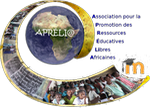Chapter 3 : Our partners' favourite dishes
 The Apréli@ Network
The Apréli@ Network
Educative e-Twinnings
Chapter 3 : Our partners' favourite dishes
Back to Travel Diary Mod : Who is who Ch 1 Ch 2 Ch 3 Ch 4 Ch 5 Ch 6 Ch 7
- Before you start working with classes, use this guidance sheet as a basis to finalise the work instructions and schedules in cooperation with your colleague partner. Make sure you record your decisions.
- At the bottom of the website screen you will find different versions of the chapter: the pdf version allows you to print without making any changes, the doc or odt versions allow you make the changes you wish to make, and then print if you want to do so.
- All exchanges of documents between partners are done by email or by using a shared virtual space, such as Dropbox (https://www.dropbox.com/).
The class will get to know the favourite food and dishes the partner class's pupils eat in different circumstances, and present them to others.
At the end of this chapter, both classes will:
- prepare an electronic cookery booklet Our partners from (name of their country, or region, or city)'s favourite dishes. In addition to recipes, the booklet will contain information about the circumstances under which these dishes are eaten.
- if school funds allow it, this booklet could be reproduced for sale to parents and community members in general.
Details
To complete this chapter, pupils will gather information on their partners’ dietary habits and their country traditional cuisine.
This will allow them to discover their partners’ customs and traditions, as well as new foods. This work on food can be linked with local history, but also with balanced diet issues, hunger and related MDG 1: Eradicate extreme poverty and hunger.
The recommended resources at the end of this chapter provide support for teachers wishing to deepen learning about nutrition, health and healthy lifestyle.
- Overall objectives
Pupils learn to collect, compare and classify information and to write recipes following cookery books conventions.
- Specific objectives
Pupils will be able to:
-
discover their partners’ eating habits and compare them with their own
-
discover the relationships between food, lifestyle and social development
-
strengthen the knowledge acquired in other school subjects, such as mathematics, science, biology, history, geography or French (e.g.: How to give instructions).
- local (to integrate the work in this chapter to the school curriculum )
- relevant school subjects
- teaching and learning objectives
- information technology objectives
- Look for recipes on the Internet.
- Use multimedia tools (text, bulleted lists and photos) to present local dishes or the carrying out of recipes.
1. Preparation
- Each class will ask the partner class to provide a list of its favourite dishes and drinks.
2. Working on answers
- In order to establish this list, each teacher conducts a survey of her/his class's favourite dishes and drinks. In the TESSA module area Life Skills, Module 1, in section 1 Ways to explore who pupils are see Resource 3 on conducting a survey To access Resource 3, click on the tab Resources).
Use questions like "What is your favourite dish?", " What is your favourite drink? " This will provide a list of all the dishes and drinks and a tally of the responses will provide the list in order of preference.
If the class is large, it can be split into two and each half will work on one of the 2 questions. (See the Key Resource on group work: Using group work in your classroom). If the class is larger, divide it into four (or more); two groups (or more) will work on the same question. The results for the same question are added to the list of the class's favourite dishes and drinks.
- The final list is then sent to the partner class.
3. Requesting more information
- Each class selects 5 or 6 dishes and drinks from the list sent by the partner class.
- The class is divided into groups (one per dish or drink). See the resource Using group work in your classroom
- Each group makes a list of information it still requires to do it presentation.
Example 1
The French pupils received the list from their Togolese partners, in which they chose the following dishes: fufu, adémè sauce, peanut sauce with chicken, braised fish.
Each dish is assigned to a group of 5 or 6 pupils. So there are 4 groups: the fufu group, the adémè sauce group, etc. Each group conducts research on the Internet (in the computer room or at home) and then writes down a few questions.
Here are the Fufu group's questions:
Fufu is in the list of your favourite dishes. We did find an article on the fufu on Wikipedia. We have seen that you can use cassava or corn to prepare it: do you eat both sorts? In our presentation we want to know how you eat it: every day? on special occasions? with fish? with meat? with sauce? at every meal? Do you have any family recipes and recipes for special circumstances?
Example 2:
Togolese pupils received the list from their French partners, in which they chose the following dishes: cassoulet, roast turkey with chestnuts, couscous, frog legs, "hazel potatoes” and "cordon bleu".
Here are the Frog legs group’s questions:
Where do you find the frog legs? Do you fish them yourselves? Where? How do you prepare them? Do you often eat this dish?
- The class sends its requests for further information to the partner class.
4. Providing more details
- On receiving the partners’ questions, the class is divided into groups according to the partner class's selected dishes. In the Togolese class there will be a fufu group, an adémè sauce group, etc. Each group takes the responsibility to answer questions.
- The class sends its answers to the partner class.
5. Preparing the Digital Travel Diary chapter for publication
- Each group writes the instruction sheet for the dish(es) or drink(s) for which it is responsible, looks for an illustration on the Internet and then keys in and saves the text together with the corresponding picture.
- All documents are sent to the partner class.
6. Validating the Digital Travel Diary chapter for publication
- The partners read the documents received on their dishes and drinks, suggest additions or changes (if necessary) before returning them.
7. On receivng corrections et modifications
- Pupils complete their recipe sheets and send them to the partner class.
The final products are available:
- Chapter 3 of the Digital Travel Diary Our Partners’ favourite dishes, made up of the collection of recipes with background notes, well written and well presented is made available to the partner class.
- If the class decides it is appropriate, a recipe booklet is available to the class, the school and the community.
- Pupils make a recipe demonstration: they cook one of the dishes in their recipe book. They photograph the key moments of the process and put them together with the appropriate text in a "recipe page" as would be found in a magazine.
- Pupils make a recipe demonstration which they film using the video function of a digital camera. The video can then be shared with the partner class.
- The teacher and pupils review the objectives set for this chapter, decide whether these have been achieved and how they know it.
- They consider what they have learned while completing this chapter, and how they can demonstrate what they have learned.
- A computer with an Internet connection
- A word processing package
- A presentation software package (optional)
- A digital camera - or a mobile phone that takes pictures and videos (optional).
For teachers who wish to explore the role of food in a healthy lifestyle, see the module:
And its supporting resources (Click on the Resources tab, and then the appropriate resource)
- Resource 1: Healthy living practices
- Resource 2: Ideas for classroom display
- Resources 3: Local food
- Apréli@ e-twinning Chapter 3: Our partners’ favourite dishes
From the TESSA OER:
- How to conduct a class survey, in Section 1 of Module 1 of Life Skills: Ways to explore who pupils are http://www.tessafrica.net/node/633. Select Resource 3
- Key Resource on group work: Using group work in your classroom http://www.tessafrica.net/files/tessafrica/kr_groupwork.pdf
- Exploration pupils’ ideas have about healthy life http://www.tessafrica.net/node/635. When you are on this page, click on the Resources tab to access the supporting resources
Back to Travel Diary Mod : Who is who Ch 1 Ch 2 Ch 3 Ch 4 Ch 5 Ch 6 Ch 7 To the top
| Home-page | The Teacher Educator's Resources (in French) |
TESSA pedagogical support | IFADEM computer literacy (in French) |
Educational resources of e-twinning @ Apréli are under Creative Commons license level 5:
paternity, not commercial use, sharing the same initial conditions
(See http://creativecommons.org/licenses/by-nc-sa/2.0/fr/)

